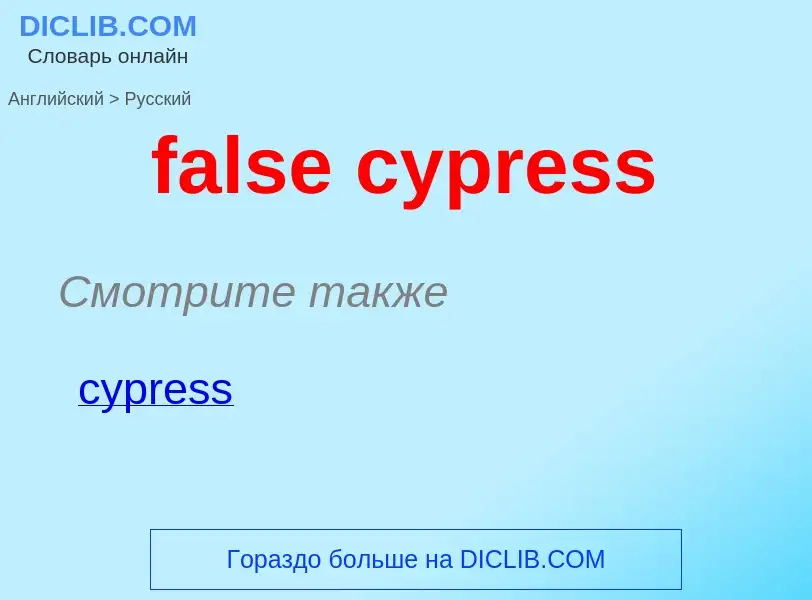Translation and analysis of words by ChatGPT artificial intelligence
On this page you can get a detailed analysis of a word or phrase, produced by the best artificial intelligence technology to date:
- how the word is used
- frequency of use
- it is used more often in oral or written speech
- word translation options
- usage examples (several phrases with translation)
- etymology
false cypress - translation to English
Смотрите также
общая лексика
"горячая линия", синхронизация данных
механизм синхронизации данных между двумя прикладными программами - изменения, внесенные одной программой, мгновенно отражаются в файлах данных другой программы
Смотрите также
общая лексика
кипарисовик туполистный (Chamaecyparis obtusa)
Definition
Wikipedia

Chamaecyparis, common names cypress or false cypress (to distinguish it from related cypresses), is a genus of conifers in the cypress family Cupressaceae, native to eastern Asia (Japan and Taiwan) and to the western and eastern margins of the United States. The name is derived from the Greek khamai (χαμαί), meaning "on the earth", and kuparissos (κυπάρισσος) for "cypress".
They are medium-sized to large evergreen trees growing from 20–70 m (66–230 ft) tall, with foliage in flat sprays. The leaves are of two types, needle-like juvenile leaves on young seedlings up to a year old, and scale-like adult leaves. The cones are globose to oval, with 8-14 scales arranged in opposite decussate pairs; each scale bears 2-4 small seeds.
- Species
- Chamaecyparis formosensis Matsum. - Taiwan
- Chamaecyparis lawsoniana (A.Murray) Parl., Port Orford cedar or Lawson cypress - California, Oregon, Washington
- Chamaecyparis obtusa (Siebold & Zucc.) Endl. - Japan
- Chamaecyparis pisifera (Siebold & Zucc.) Endl. - Honshu, Kyushu
- Chamaecyparis taiwanensis Masam. & Suzuki - Taiwan
- Chamaecyparis thyoides (L.) Britton, Atlantic white cedar (among other names) - Eastern United States (Mississippi to Maine)
Chamaecyparis taiwanensis is treated by many authors as a variety of C. obtusa (as C. obtusa var. formosana).
Genus Fokienia is not always recognized as a separate genus from Chamaecyparis, in which case Chamaecyparis hodginsii (=Fokienia hodginsii) should be added to the above list. On the other hand, a species which used to be included in this genus, as Chamaecyparis nootkatensis, had been transferred on the basis of strong genetic and morphological evidence to the separate genus Xanthocyparis as Xanthocyparis nootkatensis in the early 2000s. After further phylogenetic work the species was moved to the monotypic genus Callitropsis nootkatensis, being sister to the genus Hesperocyparis, and both genera forming a clade with Xanthocyparis as its sister.
There are also several species described from the fossil record including:
- †Chamaecyparis eureka Middle Eocene, Axel Heiberg Island, Canada.
- †Chamaecyparis linguaefolia Early-Middle Oligocene, Colorado, USA.
- †Chamaecyparis ravenscragensis (=Fokienia ravenscragensis), if genus Fokienia is not recognized.
Chamaecyparis species are used as food plants by the larva of some Lepidoptera species, including juniper pug and pine beauty.



![A Cypress USB [[microcontroller]] A Cypress USB [[microcontroller]]](https://commons.wikimedia.org/wiki/Special:FilePath/Saleae Logic8 IMG 2876 (cropped) CY7C68013A.jpg?width=200)
-樹齢約700年の大ヒノキdaichiji008.jpg?width=200)

![bark]] is used as a traditional roofing material (''[[hiwadabuki]]'') at [[Tō-ji]] in [[Kyoto]] bark]] is used as a traditional roofing material (''[[hiwadabuki]]'') at [[Tō-ji]] in [[Kyoto]]](https://commons.wikimedia.org/wiki/Special:FilePath/Kyoto Toji Hiwadabuki C0990.jpg?width=200)


![[[Tanzawa Mountains]], Japan [[Tanzawa Mountains]], Japan](https://commons.wikimedia.org/wiki/Special:FilePath/Chamaecyparis obtusa 01.jpg?width=200)

